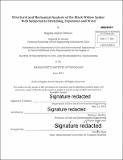Structural and mechanical analysis of the black widow spider web subjected to stretching, expansion and wind
Author(s)
Demian, Bogdan Andrei
DownloadFull printable version (13.12Mb)
Other Contributors
Massachusetts Institute of Technology. Department of Civil and Environmental Engineering.
Advisor
Markus J. Buehler.
Terms of use
Metadata
Show full item recordAbstract
The web of the black widow is apparently a random spatial arrangement of threads, which provides its occupant with housing, means to capture prey and protection. However to ensure that these functions are fulfilled, the spider has evolved to adapt the architecture of the web so that it would be able to adequately respond to the outer environment and to properly transmit the stresses within its structure. By performing the structural analysis of the web subjected to various external loads, a relationship between the web geometry and mechanical response may be established. For this study, a web model constructed based on data collected from a member of the species Latrodectus mactans (southern black widow) is tested under three loading conditions: uniaxial stretching, expansion in the three main directions and shearing effects of the wind action. In addition, to determine whether the response of the erratic ensemble of threads is efficient as compared to a more orderly system, a second structure constructed from elements of equal lengths organized in simplistic pattern is subjected to similar tests and results are compared. These tests indicate a complex flow of stresses throughout the network. Unlike the elements in the orderly system, which carry approximately the same amount of load, the individual response of the threads in the web varies significantly, with some experiencing very large stresses, while others not being loaded at all. This shows that the high degree of redundancy in the web allows for multiple possible load paths, redirecting stresses in certain regions of the structure, while maintaining others safe for the spider to continue inhabiting them. However, while certain patterns may be observed in the way load is carried throughout the web, these tests fail to establish a concrete correlation between geometry and stress flow.
Description
Thesis: M. Eng., Massachusetts Institute of Technology, Department of Civil and Environmental Engineering, 2014. Cataloged from PDF version of thesis. Includes bibliographical references (pages 57-61).
Date issued
2014Department
Massachusetts Institute of Technology. Department of Civil and Environmental EngineeringPublisher
Massachusetts Institute of Technology
Keywords
Civil and Environmental Engineering.